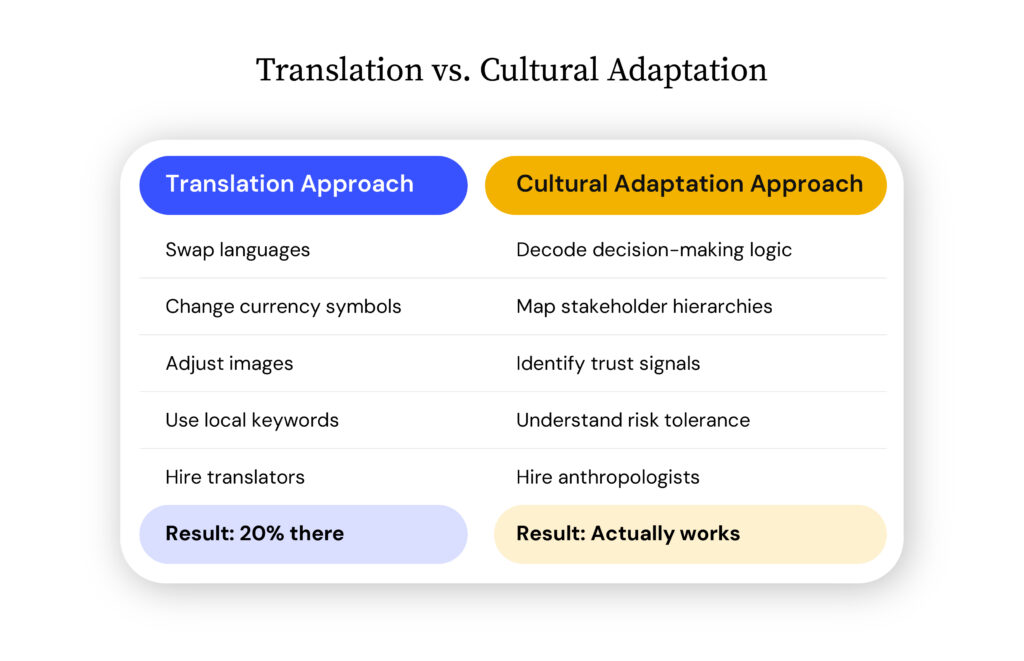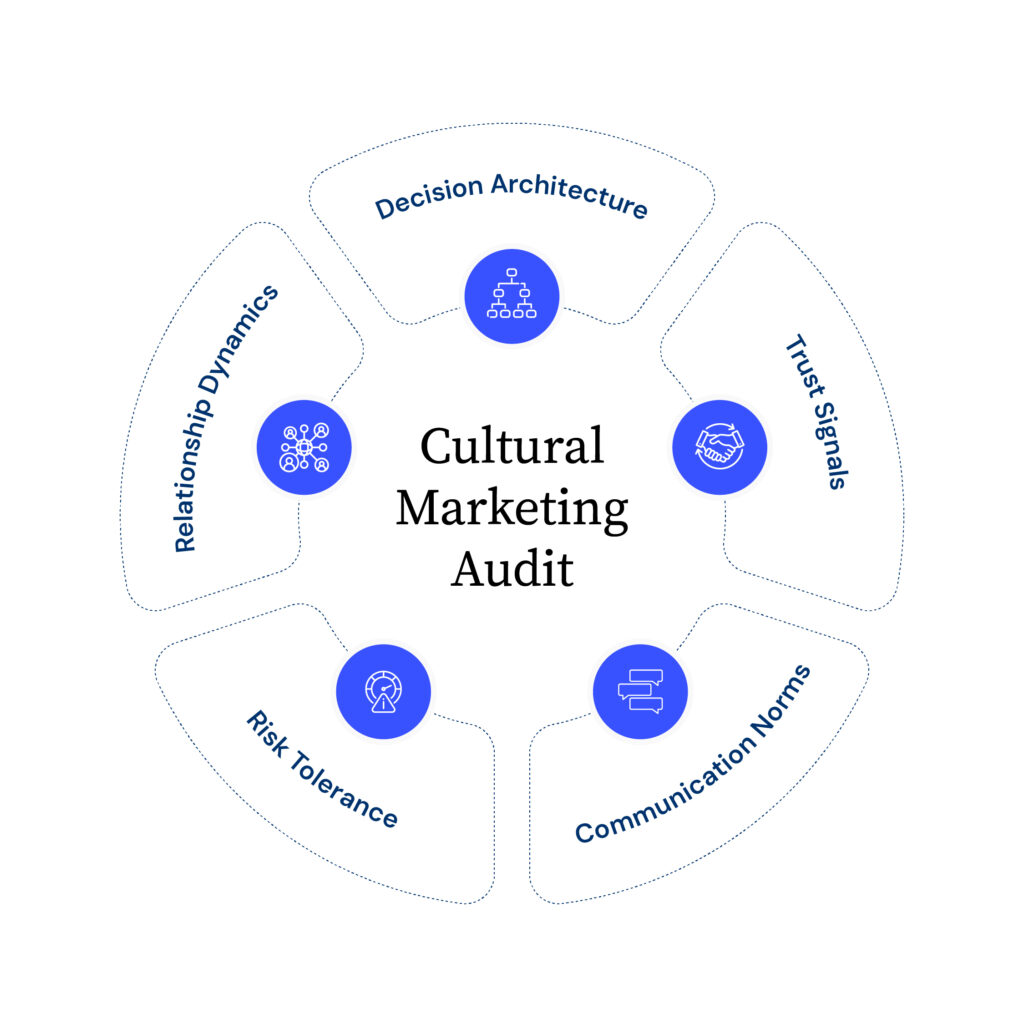Summary
Most companies think global marketing means translating their message into different languages. It doesn't. The real challenge isn't finding the right words in German or Mandarin. It's understanding that business cultures operate on completely different logic. Success means grasping how different markets make decisions, build relationships, and perceive risk in ways that fundamentally reshape your entire marketing approach.
Here’s what usually happens when a company decides to “go global.”
They hire a translation agency, swap out dollar signs for euros, maybe photoshop their website hero image to look less obviously American, and boom. Localized.
Then six months later, they’re sitting in a strategy meeting completely baffled. Why did their killer campaign just die in Germany? Why did their straightforward sales pitch somehow offend every prospect in Japan?
Why is nobody responding?
Here’s the thing: your audience isn’t confused.
You are.
Language is actually the easy bit
Look, translation is table stakes. But what actually kills global campaigns isn’t bad grammar. It’s cultural code. The invisible rulebook that dictates how people in different markets make decisions, build trust, and figure out what’s valuable.
Here’s a real example: A SaaS company had a case study-heavy approach that absolutely crushed it in North America. Makes sense. American buyers love peer validation and move fast. They took the exact same approach to Germany.
Dead.
Nothing. Turns out German buyers want technical specifications, official certifications, and exhaustive product documentation before they’ll even consider a conversation. The translations were perfect. The strategy was completely wrong.

It’s not about language
Think about hierarchy for a second.
In many Asian markets, purchasing decisions flow through multiple stakeholder layers with very specific approval chains. So, your entire “get straight to the decision-maker” playbook? It doesn’t just underperform. It fundamentally misreads how decisions actually happen in that culture.
You’re essentially trying to play football using basketball rules and wondering why nobody’s scoring.
This is why companies need people who think like anthropologists. Not just translators. People who ask: How do relationships actually work here? What does risk mean to buyers in this market? How does hierarchy shape who talks to whom, and when?
What are the unspoken rules everyone follows, but nobody explains?
When teams finally get this right
There’s a pattern in companies that figure this out.
Content programs that stop obsessing over conversion rates and instead focus on relationship building. Because that’s how certain markets actually work. Sales cycles that get extended by months (yes, months) to respect consensus-driven decision processes. Brand messaging that gets completely reimagined because “professional” means something totally different in Singapore than it does in San Francisco.
The companies winning in global markets aren’t translating.
They’re rebuilding.
The uncomfortable questions
Here’s where it gets real.
Your entire marketing framework might be culturally specific. Those funnel stages you love? American bias toward linear progression. Your obsession with speed? Very Western. That casual, friendly brand voice?
Confusing or inappropriate in markets that value formality and hierarchy.
The companies that actually figure out global marketing are the ones willing to ask uncomfortable questions. Does our “move fast” sales model completely disrespect how this market prefers to buy? Is our content solving for American buyer personas while ignoring what local stakeholders actually care about?
Are we measuring success against metrics that only make sense in our home market?
It’s humbling. And necessary. But mostly humbling.
Because here’s what nobody wants to admit: most marketing playbooks aren’t universal. They’re not even close. What passes for “best practice” is often just “what works in my home market.” And the gap between those two things? That’s where global campaigns go to die.
So what actually works?
Start with deep market immersion before you write a single piece of content.
Not a two-hour briefing call. Not a market research report someone else compiled. Actual immersion. Talk to buyers in that market. Understand their decision-making cadence. Map out who influences whom. Figure out what trust signals matter there, not what you assume should matter.Here’s a framework that helps: The cultural marketing audit
Decision architecture: How do companies in this market actually make buying decisions? Who’s involved? What’s the sequence? What gets discussed formally vs. informally?
Trust signals: What builds credibility here? Certifications? Long-term relationships? Technical depth? Brand heritage? Peer recommendations?
Communication norms: What’s the expected tone? Level of formality? Directness vs. indirection? How much context do people need before getting to the point?
Risk tolerance: Is this a “move fast and iterate” culture or a “get it right the first time” culture? How does that shape content strategy and sales approach?
Relationship dynamics: Are business relationships transactional or long-term? How much investment in relationship building is expected before commercial discussions?

Sounds straightforward, right?
It’s not. Because the real challenge isn’t asking these questions. It’s interpreting the answers without filtering them through your own cultural lens. It’s catching the nuances that locals won’t explicitly tell you because they assume everyone just knows. It’s recognizing patterns across multiple stakeholders that reveal deeper cultural logic.
This is where most teams stumble. They do the research, check the boxes, and still miss what actually matters because they’re looking for answers that confirm what they already believe.
The companies getting this right? They’re usually working with people who have genuine cross-cultural fluency. People who’ve lived the complexity, not just studied it. Who can spot when a “yes” in one market means “maybe” and when “we’ll think about it” actually means “no.” Who understand that three months of relationship-building in some markets isn’t slow, it’s just how things work.
If you’re expanding into markets where the cultural gap is wide, this probably isn’t work you want to figure out through trial and error. The cost of getting it wrong, repeatedly, adds up faster than you think.
Going global isn’t about making your marketing bigger.
It’s about making your thinking bigger. And being willing to rebuild your entire approach around how different markets actually operate, not how you wish they did.
Expanding into new markets and wrestling with these challenges? These are exactly the conversations we have with marketing leaders navigating cultural complexity. Sometimes an outside perspective from people who’ve done this across multiple markets helps you avoid expensive mistakes. Let’s connect!
Key takeaways: Translation is only a starting point—maybe 20% of the challenge—while the remaining effort lies in decoding each market’s decision architecture, trust signals, risk tolerance, and relationship dynamics that often render home-market playbooks culturally biased or counterproductive. That’s why deep immersion must precede content and campaigns, and why true cultural fluency—practitioners who have genuinely lived and worked across contexts—is essential to map stakeholder hierarchies, interpret communication norms, pace consensus-driven processes, rebuild strategy around how buying actually happens, and measure success with locally relevant signals rather than home-market KPIs.






